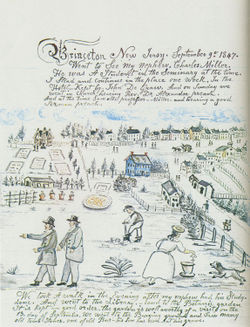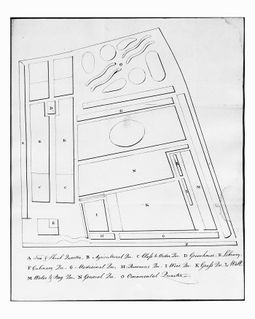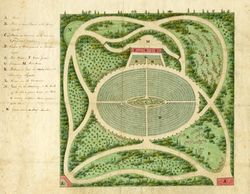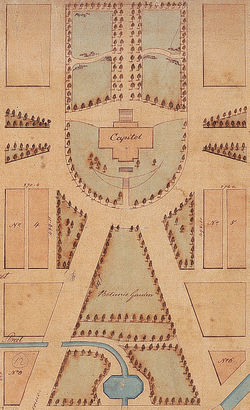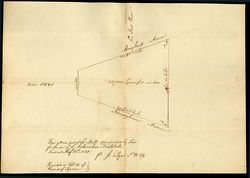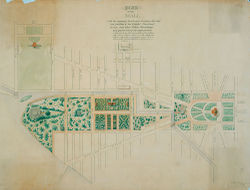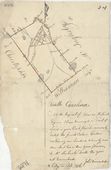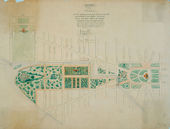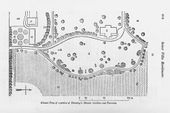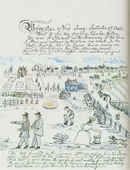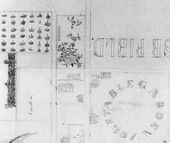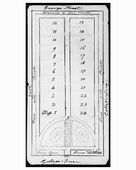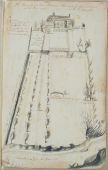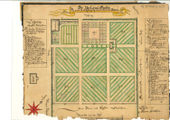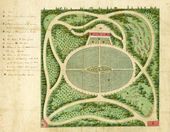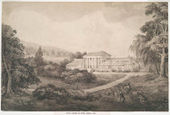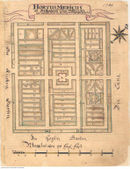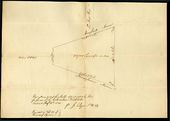Botanic garden
(Botanical garden, Botanick garden)
See also: Nursery
History
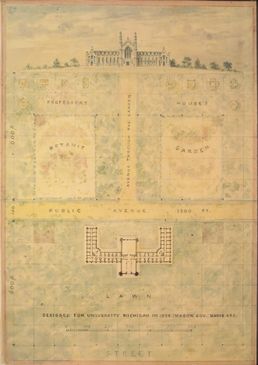
Treatises indicate that the primary object of the botanic garden was to serve the science of botany, the study of plants. The collection and organization of living plants growing in a garden provided a living laboratory for observers’ experimentation. To promote study, botanic gardens were generally arranged according to a classification system that created groupings of plants based on certain scientific principles; generally, in antebellum America, the Linnaean and Jussieu’s natural systems of taxonomic nomenclature were used. The botanic garden as a garden type was encouraged and stimulated by the transatlantic exchange of botanical information and material.
From the earliest period of colonization, European collectors, nurserymen, and natural scientists contracted agents in the New World to establish botanic gardens and to send specimens back to Europe. These gardens, such as the Bartram Botanic Garden and Nursery in Philadelphia and those of François André Michaux in Bergen, New Jersey, and Charleston, South Carolina, acted as collecting sites for native plants, as well as centers for the introduction of plants into America. Many early American botanic gardens were associated with medical schools or universities [Fig. 1]. The gardens of Columbia College in New York, Harvard, the University of Pennsylvania, Princeton College [Fig. 2], and the University of South Carolina, for example, were all founded within the first two decades of the 19th century.
Other botanic gardens were privately owned and exemplified not only the pursuit of science but also the passion for collecting that characterized the Enlightenment [Fig. 3]. The network of early botanical collectors in America included the most prominent members of the ruling elite. They carried on an exchange of plants and botanical knowledge that involved an international network of plant collectors and botanists. One of the finest collections in the colonial and early republican eras was located at William Hamilton's seat, The Woodlands, near Philadelphia, built between 1779 and 1789. Manasseh Cutler, upon whom we rely for many descriptions of early American gardens, reported that “there was not a rare plant in Europe, Asia, Africa, from China and the islands in the South Sea, of which [Hamilton] had any account which he had not procured.”[1] At Mount Vernon, George Washington used the phrase “botanical garden” to refer to that part of his garden where he experimented with rare plants (view text).
Cities, towns, and the federal government attempted to establish botanic gardens for economic reasons, as well as to promote civic or national pride. Such gardens were built from Boston to Florida promoting these goals. Numerous records document the utility of these garden types in the development of agriculture, medicine, and horticulture.
The physical design of botanic gardens included simple rectangular beds that were divided into regular sections or rows, as in the plan of the garden of Solomon Drowne at Brown University [Fig. 4]. They could also be characterized by complex combinations of designed pleasure grounds with collections of botanically arranged plants, as in Robert Mills's designs of 1841 of the Mall. Another category of botanic garden was the commercial nursery. Several examples, such as the Linnaean Botanic Garden and Nurseries, Flushing, New York (1771–1871), and André Parmentier’s Horticultural and Botanical Garden, Brooklyn, New York (1826), offered a wide variety of exotic plants as well as garden displays to attract the consumer.
During the course of the late 18th and early 19th centuries, the botanic garden was influenced by an increasing taste for the natural style of landscape design, as well as the interest in public gardens and parks. Parmentier’s Horticultural and Botanical Garden was famous for its presentation of a scientific collection in the most modern style with great taste. By the mid-19th century, these trends led to a shift in the nature of the institution so that botanic gardens became emphatically oriented as much toward the education and entertainment of the public and beautification of the site as toward the advancement of botany. This transformation is exemplified in the history of the Mall, which was the site of a succession of botanic gardens dating from the earliest plans for the new capital city.[2]
—Therese O'Malley
Texts
Usage
- Middleton, Dr. Peter, 1769, regarding the establishment of a botanic garden in New York, NY (quoted in Hosack 1811: 5)[3]
- “As this continent yields most of the medical plants now in use, and abounds also with a variety of others, whose qualities we are as yet but little acquainted with, or entire strangers to; may we not hope, that among the future literary institutions in this place, a teacher of botany will soon be appointed, and a botanical garden laid out, and properly furnished?"
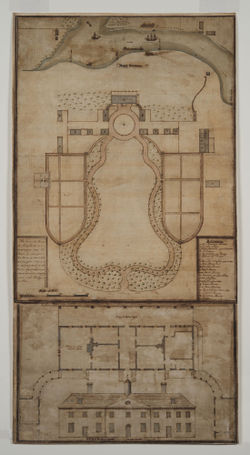
- Washington, George, 1785 and 1786, describing Mount Vernon, plantation of George Washington, Fairfax County, VA (Jackson and Twohig, eds., 1978: 4:161, 308, 350)[4]
- “[8 and 13 July] Sowed one half the Chinese Seed given me by Mr. Porter and Doctr. Craik, in three rows in the Section next the Quarter (in my Botanical garden) beginning in that part next the garden Wall, and at the end next the Middle Walk. . .
- “[11 April 1786] In the Section in my botanical garden, next the House nearest the circle, I planted 4 Rows of the laurel berries in the grd. where, last year I had planted the Physic nuts &ca.—now dead & next to these in the same section are [ ] rows of the pride of China. The Rows of both these kinds are 16 inches asunder & the Seeds 6 inches apart in the Rows. . .
- “[19 June] A Monsr. Andri Michaux—a Botanest sent by the Court of France to America (after having been only 6 Weeks returned from India) came in a little before dinner with letters of Introduction & recommendation from the Duke de Lauzen, & Marqs. de la Fayette to me. He dined and returned afterwards to Alexandria on his way to New York, from whence he had come; and where he was about to establish a Botanical garden.” [Fig. 5] back up to History
- Cutler, Manasseh, July 13, 1787, describing Philadelphia, PA (1987: 1:257–58)[5]
- “He [Benjamin Rush] observed that they were endeavoring to raise a fund for establishing a Botanical Garden in that city, which he hoped they should be able to effect, and assured me that I was the only person who had been in nomination to take the superintendency, and give the Botanical lectures to the students in Physics of the University.”
- New York Agricultural Society, 1794, regarding the establishment of a botanic garden at Columbia College, New York, NY (quoted in Hosack 1811: 6)[3]
- “The establishment of a garden is nearly connected with the professorship of botany under the college, and the lectures on that branch must be always very lame and defective without one. . . A botanical garden is not only one of the most useful and most important of public improvements, but it also comprises within a small compass the history of the vegetable species of our own country; and by the introduction of exotics, makes us acquainted with the plants of the most distant parts of the earth. Likewise, by facilitating experiments upon plants at this time, when a true theory of nutrition and manures is such an interesting desideratum, a botanic garden may be considered as one of the means of affording substantial help to the labours of the Agricultural Society, and be conducive to the improvement of modern husbandry. When these things are duly considered, it can scarcely be doubted, that a botanic garden, under the direction of the society, or of the college, with a view to further the agricultural interest, will be set on foot and supported by legislative provision: to the end that young minds be early imbued with proper ideas on this important subject.”
- Dwight, Timothy, 1796, describing Cambridge, MA (1821: 1:483)[6]
- “In the year 1805, $30,833 were raised in Boston, and the other wealthy towns in this vicinity, for the establishment of a Botanic garden, and professorship. The Professor has been chosen, and inducted into office. His official title is professor of Natural History. I know not whether the garden has been begun.” [Fig. 6]
- Michaux, François André, 1802, describing the botanic garden of François André Michaux, near Charleston, SC (1805: 12–14)[7]
- “As soon as I had recovered, I quitted Charlestown, and went to live at a small house, ten miles from the city, where my father had formed a botanic garden. Here he had collected and cultivated with great care the plants which he found in the long and fatiguing journeys which his ardent love of science made him take, almost every year, through the different countries of America. . . At my arrival in Carolina, I found, in this garden, a beautiful collection of trees and plants of the country, which had survived an almost total neglect, for four years. I also found a great number of trees from the old continent, which my father had planted there, some of which gave marks of the most vigorous vegetation. . . The agricultural society of Carolina are now in possession of this garden, which they propose to continue, and to cultivate in it those useful vegetables of the old continent, which, from the resemblance of climate, promises a chance of success.”
- Anonymous, November 25, 1805, describing the Museum Naturae, Norfolk, VA (Norfolk Gazette and Publick Ledger)
- “MUSEUM NATURÆ, of Norfolk and Portsmouth. . .
- “Botanical Garden, containing specimens of all the vegetable productions of this country, and furnished with green-houses, for all such exotick and rare plants, as may be procured from abroad. . .
- “He takes the liberty of soliciting the aid and assistance of the Inhabitants of this State, for the speedy increase of the collections, by favouring his infant institution with all such natural productions and curiosities, as they may have in their possession, and have no particular use for: whether Animals, living or dead; Vegetables, or Minerals. Every object thus proffered, will be carefully preserved, with the name of the donor thereof; and will serve as a lasting proof of his taste and love for Arts and Science, and of his liberality towards the Institution.
- “Subscriptions for the forwardness and increase of this undertaking, at the rate of 25 dollars. . . are still solicited and received at the Museum.”
- Hosack, David, 1806, describing Elgin Botanic Garden, New York, NY (1806: 3–6)[8]
- “The establishment of a Botanic Garden in the United States, as a repository of native plants, and as subservient to medicine, agriculture, and the arts, is doubtless an object of great importance.
- “In the year 1801 I purchased, of the Corporation of the city of New-York, twenty acres of ground; the greater part of which is now in cultivation. Since that time, a Conservatory, for the more hardy green-house plants, has been built; in addition to which, two Hot-Houses are now erecting for the preservation of those plants which require a greater degree of heat.
- “The grounds will be arranged in a manner the best adapted to the different kinds of plants, and the whole enclosed by a belt of forest trees and shrubs, native and exotic. [Fig. 7]
- “A primary object of attention in this establishment will be to collect and cultivate the native plants of this country, especially such as possess medicinal properties, or are otherwise useful. . .
- “It is also my intention to introduce, from different parts of the world, such plants as are most useful in agriculture, in medicine, and the arts, and to ascertain which of them are capable of being naturalized to our soil and climate. There is no doubt that our agriculture may be much improved by the introduction of many foreign grasses and other plants cultivated as food for cattle; and many valuable additions may be made to our tables, by the importation of the best fruits and vegetables of foreign countries.
- “Another object of importance is, to afford to students of medicine the means of acquiring a knowledge of the natural history of plants, and the principles of botanic arrangement, a science intimately connected with their profession, as it not only enables them to distinguish one plant from another, but frequently leads to an acquaintance with their qualities and uses. For this purpose the grounds will be divided into different compartments, calculated to exhibit the various plants according to their several properties; and these again will be arranged so as to afford a practical illustration of the systems of botany at present most esteemed, the sexual system of Linnaeus, and the natural orders of Jussieu. . .
- “A Botanic Garden, therefore, while it proves useful to society, and contributes to the improvement of science, cannot fail to enhance the reputation of the Medical School of New-York. This, and similar considerations, it is to be presumed, will induce the Legislature of the State, at a future day, to extend its patronage and protection to an institution the first of its kind that has been attempted in the United States.*
- “*I learn, with pleasure, that a Botanic Garden is proposed to be established near Boston, and connected with the University of Cambridge. . . Another is also begun at Charleston (South-Carolina), and a third is contemplated in New-Jersey, in connection with the College of Princeton.”
- Anonymous, May 11, 1807, describing a botanic garden in Charleston, SC (Charleston Courier)
- “Botanick Garden of South-Carolina.—This excellent establishment has succeeded beyond the expectations of the projectors; and from the liberal support which it is daily receiving, it becomes more valuable and more generally useful. If we take into consideration the infancy of the institution, it has to boast of as large a collection of plants, as any garden in the United States, and it is peculiarly rich in rare and valuable exoticks. An opportunity is now offered to the lovers of science, to acquire a knowledge of the most beautiful and interesting of the works of nature. The Florist may be gratified with viewing the productions of the remotest clime, and the Medical Botanist with the objests [sic] of his study.
- “The expense of contributing to the support of this excellent national institution, is so very trifling, that almost every person can afford it. Four Dollars a year is an inconsiderable sum when compared with the usefulness of the establishment. The garden is at a convenient distance from the city, and affords an agreeable recreation both to those who visit it merely for amusement, and who seek it for information.
- “We have just been informed, that the committee, knowing the difficulty of procuring Medical Herbs, when sickness may render them peculiarly desirable, have determined to appropriate a part of the Garden, for the culture of Baum, Horehound, &c. for the sole use of the subscribers. This will render the institution of general use to its supporters, who will likewise be supplied, at the proper season, with such plants and seeds as can be spared.”
- Anonymous, 1808, proposal for a botanic garden, published in the Washington Expositor (quoted in O’Malley 1989: 102)[9]
- “Within the limits of the federal seat there are large and ample reservations for public gardens and other national objects, which may advantageously be applied to the purposes of a botanical garden, a public nursery and an agricultural farm.” [Fig. 8]
- Jefferson, Thomas, July 14, 1808, in a letter to Monsieur de la Cépèd, describing The Woodlands, seat of William Hamilton, near Philadelphia, PA (1944: 373)[10]
- “In the meantime, the plants of which he [Governor Lewis] brought seeds, have been very successfully raised in the botanical garden of Mr. Hamilton of The Woodlands, and by Mr. McMahon, a gardener of Philadelphia.”
- M’Mahon, Bernard, January 3, 1809, describing a nursery and botanic garden in Philadelphia, PA (quoted in Jefferson 1944: 401)[10]
- “Last month I purchased in the vicinity of this City [Philadelphia] 20 Acres of ground, well adapted for a Nursery & Botanic Garden, and hope that, in a few years, I shall enrich that spot, and through it, in some measure, the country in general, with as extensive and useful a collection of vegetable productions, as can reasonably be expected from the small means of which I am possessed.”
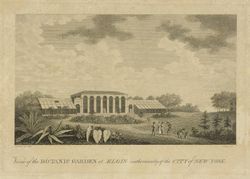
- Commonwealth of Pennsylvania, Twentieth House of Representatives, Legislative Committee Report, March 5, 1810, describing Elgin Botanic Garden, New York, NY (quoted in Miller et al., eds., 1991: 3:24)[11]
- “By complying with the request of your memorialist, your committee are persuaded that the museum, which has acquired a deserved reputation in Europe, would greatly contribute to perserve [preserve] to Pennsylvania that distinguished rank amongst her sister states. . .
- “And when your committee reflect that the state of New York has lately purchased for the use of the state, the excellent botanic garden formed by Doctor Hosack, they flatter themselves the example will justify your committee in offering this extraneous remark.” [Fig. 9]
- Pursh, Frederick, 1814, describing Elgin Botanic Garden, New York, NY (1814: xv)[12]
- “I was called upon to take the management of the Botanic Garden at New York, which had been originally established by the arduous zeal and exertions of Dr. David Hosack, Professor of Botany, &c. as his private property, but has lately been bought by the Government of the State of New York for the public service. . . in 1807 [I] took charge of that establishment.
- “Here I again endeavoured to pay the utmost attention to the collection of American plants, as the establishment was principally intended for that purpose. In this I was supported by my numerous botanical connections and friends, among whom I must particularly mention John Le Conte, Esq. of Georgia, whose unremitting exertions added considerably to the collection, particularly of plants from the Southern States.”
- Cutbush, Dr. Edward, June 1816, describing the Columbian Institute, Washington, DC (quoted in O’Malley 1989: 115)[9]
- “There is scarcely an art, science, or manufacture, which may not be benefited by this association; and should we be so fortunate as to succeed in establishing a botanical garden, it may excite an emulation among the proprietors of the eminences around our city, by inducing them to cultivate and adorn those beautiful heights with gardens; no city in the United States presents a greater assemblage of sublime views; nothing is wanting but industry, public spirit, and population, to render them not only pleasing to the eye, but highly advantageous to this district.”
- Jefferson, Thomas, February 18, 1818, in a letter to David Hosack, describing the Elgin Botanic Garden, New York, NY (1944: 578)[10]
- “I received some time ago from M. Thouin, Director of the Botanical or King’s garden at Paris, a box containing an assortment of seeds, Non-American. . . I have therefore this day sent the box to Richmond. . . to be forwarded to you for the use of the Botanical garden of N. York. . . I am happy in this disposition of it to fulfill the good intentions of the donor, and to make it useful to your institution.” [Fig. 10]
- Memorial of the Columbian Institute, December 1818, describing the Columbian Institute, Washington, DC (quoted in O’Malley 1989: 123)[9]
- “[ Columbian Institute lottery for] enclosing the grounds, for the erection of their hall—their laboratory—their hot and green houses,—their library and museum, and for the cultivation of the botanic garden, wherein they hoped ‘to soon present to the view of their fellow citizens specimens of all the plants of this middle region of our country, with others exotic and domestic. . . for the promotion of a great national object.’” [Fig. 11]
- Guild, Benjamin, September 20, 1823, “Botanic Garden” (New England Farmer 2: 62)[13]
- “At a meeting of the board of visiters [sic] of the Massachusetts Professorship of Natural History, September 13, 1823—
- “The Curator of the Botanic Garden stated, that George Brown, Esq. of Beverly, had presented to the Garden, a very interesting and extensive collection of seeds, and three large boxes of living plants, obtained by him from the royal garden at Rio Janeiro.”
- Hunt, Henry, William P. Elliot, and William Thornton, 1826, committee requesting a Memorial to the House of Representatives of the Congress in Washington, DC (U.S. Congress, 19th Congress, 1st Session, House of Representatives, doc 123, book 138)
- “That, with a view to promote the public good, and to ornament and improve the public grounds, they would recommend. . . That a wall five feet high, with a stone coping, be put round the ground appropriated for a Botanic Garden; and that suitable buildings be erected, and the Garden be properly laid out, and cultivated as a National Garden; to effect which important national objects, a sum not exceeding 30,000 dollars will be required. . . This National Botanic Garden may be used to raise all kinds of indigenous and exotic trees, shrubs, roots, grasses, &c. to be distributed to every part of the Union.”
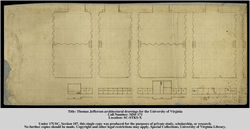
- Jefferson, Thomas, August 3, 1826, describing plans for a botanic garden at the University of Virginia, Charlottesville (1944: 596–97)[10]
- “The botanical garden, after being laid off under the direction of Dr. Emmett, to be pursued at all spare time.” [Fig. 12]
- Commissioner of Public Buildings, June 9, 1827, describing the Columbian Institute, Washington, DC (quoted in O’Malley 1989: 133)[9]
- “The Botanic Garden belonging to your Institute is so directly in view from the Capitol, that I hope to be pardoned for a remark in relation to the improvement of it. . . I would be gratified by the location of the Botanic Garden in its present site from an expectation that it would become an ornamental appendage to the Capitol, and that under the eye of Congress they would be induced to foster it.”
- Anonymous, July 31, 1829, describing in the American Farmer the first semi-annual “Exhibition of Fruits, Flowers, and Plants” of the Pennsylvania Horticultural Society at the Masonic Hall, Philadelphia, PA (quoted in Boyd 1929: 44)[14]
- “The recent exhibition collected together for a single day the fragrant and smiling offspring of the earth, in their richest odours and their gaudiest hues,—and then restored them to the possession of their public-spirited and generous proprietors. It afforded, however, a short and limited representation of what is hoped for in the continuing and extended charms of a Botanical Garden.”
- Guild, Benjamin, August 28, 1829, “Medical Botany, Horticulture Experiments, &c.,” describing plans for a botanic garden in Massachusetts (New England Farmer 8: 46)[15]
- “At a meeting of the Board of Visitors of the Massachusetts Professorship of Natural History, held August 8, 1829,
- “VOTED, That the Curator of the Botanic Garden be requested to publish in the NEW ENGLAND FARMER, the results of any experiments he may have made in the raising of valuable medicinal and other plants, not generally cultivated in New England, and especially such as are now imported by druggists, and are costly, but which may be easily and extensively raised in this part of the United States; and that he state particularly any circumstances in regard to the choice of soil and situation which may be important. And also that he be requested to communicate from time to time to the public, through the same paper, any horticultural experiments of his own, or any information he may possess, the communication of which in his opinion would be useful, and that this be done under his own name as Curator of the Botanic Garden.”
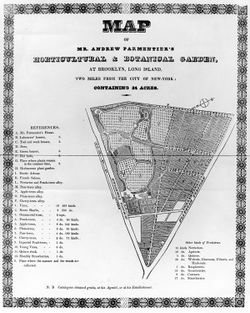
- S., J. W., February 1832, “Foreign Notices: North America,” describing André Parmentier’s Horticultural and Botanical Garden, Brooklyn, NY (Gardener’s Magazine 8: 70–71)[16]
- “. . . an account of one of the first botanic gardens which has ever been established in this country, viz. that of Parmentier, about two miles from Brooklyn, Long Island. The following map. . . will serve to convey some idea of the general disposition of the whole; but I am confident that neither plan nor description can furnish any adequate idea of the particular beauties of the place. Its establishment may, indeed, be looked upon as an epoch in the history of American horticulture; as, though the various branches of that science were before understood and practised by most of our gardeners, it had not attained its full perfection until the arrival of M. Parmentier. . . the garden of M. Parmentier, is, perhaps, the most striking instance we have of all the different departments of gardening being combined extensively and with scientific skill. The rapidity with which this garden was formed added to its effect. Nearly twenty-five acres of ground were originally enclosed; and the inhabitants of the vicinity beheld, with astonishment, in the short space of three years, one of the most stony, rugged, sterile pieces of ground on the whole island, which seemed to bid defiance to the labours of man, stored with the most luxuriant fruit, and blooming with the most beautiful flowers.” [Fig. 13]
- Wynne, William, June 1832, “Some Account of the Nursery Gardens and the State of Horticulture in the Neighbourhood of Philadelphia,” describing the Bartram Botanic Garden and Nursery, vicinity of Philadelphia (Gardener’s Magazine 8: 272–73)[17]
- “I shall begin with Bartram’s Botanic Garden; the precedence being due to it, both for antiquity (it having been established 100 years), and from its containing the best collection of American plants in the United States. There are above 2000 species (natives) contained in a space of six acres, not including the fruit nursery and vineyard, which comprise eight acres. . . Indeed, the most remarkable feature in this nursery, and that which renders it superior to most of its class, is the advantage of possessing large specimens of all the rare American trees and shrubs; which are not only highly ornamental, but likewise very valuable, from the great quantities of seed they afford for exportation to London, Paris, Petersburgh, Calcutta, and several other parts of Europe, Asia, and Africa. This garden is the regular resort of the learned and scientific gentlemen of Philadelphia.”
- Martineau, Harriet, 1835, describing Cambridge, MA (1838: 2:97)[18]
- “After refreshing ourselves with lemonade we set out for the Botanic Garden, which is very prettily situated and well taken care of. Here I saw for the first time red water-lilies. None are so beautiful to my eyes as the white; but the red mix in well with these and the yellow in a large pond. There were some splendid South American plants; but the head gardener seemed more proud of his dahlias than of any other individual of his charge.”
- Columella [pseud.], March 1, 1838, “Experimental Farm and Garden” (Horticultural Register 4: 89)[19]
- “By a union of the funds of the Massachusetts Agricultural and Horticultural Societies, and the Botanical Department of Harvard University, with the generous co-operation of the officers and members of these three institutions, as well as of the affluent, intelligent and liberal throughout the State, an establishment, of the character proposed, could be formed in the vicinity of Boston, which would do more to diffuse a knowledge of the science and art, and a taste for husbandry, gardening and botany, and to advance the general weal, than has been accomplished, or it is possible to effect, while each of these very valuable institutions is acting with limited means, and independent of the others.
- “There is a tract of land in Brookline, owned by the Hon. David Sears, and Ebenezer Francis, Esq., near the termination of the Western Avenue, where from one hundred and fifty to two hundred acres could be selected, remarkably well adapted for the various purposes of a spacious farm, and Horticultural and Botanical Gardens of Experiment. Its topographical features, and proximity to the capital, recommend it in preference [illegible] with a proper distance for the convenience of those persons who may be the most active in the foundation, and interested in the success of the establishment.”
- Anonymous, June 1, 1838, “Miscellaneous Matters,” describing a proposed botanic garden in Boston, MA (Horticultural Register 4: 239)[20]
- “THE BOTANIC GARDEN.—A Meeting of the subscribers to the Botanic Garden, to be established by consent of the city on the vacant lands west of Charles Street, fronting the common, was held on Saturday afternoon, June third, and the subscription lists bearing a sufficient number of names and amount of money to warrant the immediate commencement of operations, the subscribers adopted a Constitution, and proceeded to the election of Five Trustees to represent them until the first Monday in October next, which was appointed as the day of annual meeting. The following gentlemen were chosen:
- HORACE GRAY, SAMUEL A. ELIOT,
- C. P. CURTIS, GEORGE DARRACOTT,
- J. E. TESCHEMACHER.
- “The amount already subscribed, is nearly $20,000. From the spirit manifested at the meeting, we feel confident that before the close of the season a commencement will have been made, and an exhibition of choice flowers presented to our citizens that shall delight and astonish them. The subscription lists are still open, and the advantage, to the subscriber of $100, to the corporate property, is the free admission of himself and household to the Gardens at any time during the hours that they are open. A barren waste will soon be converted into a delightful promenade—a paradise in miniature.—Transcript.”
- Gordon, Alexander, November 1, 1838, “Orange Groves of Florida” (Horticultural Register 4: 419)[21]
- “At a former period St. Augustine could boast of a very extensive Botanic Garden. It was enclosed by a formidable stone wall, and, I believe, established by Governor White. This place now serves for the pen of a herd of swine, which, with the exception of a few ancient fruit trees, appear the only tenants of a spot once devoted to the choicest gifts of Flora.”
- Poinsett, Joel Roberts, 1841, describing the National Institute, Washington, DC (1841: 33, 49)[22]
- “It will be one of the most cherished objects of the National Institution, to establish, at some future day, a botanic garden, where plants of every country and every clime may be introduced, and their properties studied. . .
- “There can be no doubt that a National Institution, such as we contemplate, having at its command an observatory, a museum containing collections of all the productions of nature, a botanic and zoological garden, and the necessary apparatus for illustrating every branch of physical science, would attract together men of learning and students from every part of our country, would open new avenues of intelligence throughout the whole of its vast extent, and would contribute largely to disseminate among the people the truths of nature and the light of science.” [Fig. 14]
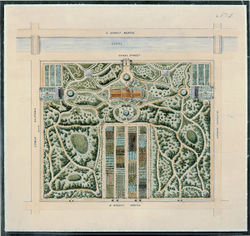
- Mills, Robert, February 23?, 1841, in a letter to Joel Roberts Poinsett, describing Mills’s design for the National Mall, Washington, DC (Scott, ed., 1990: n.p.)[23]
- “Agreeably to your requisition to prepare a plan of improvement to that part of the Mall lying between 7th and 12th Street West for a botanic garden. . . I have the honor to submit the following Report. . .
- “The principle upon which this plan is founded is two fold, one is to provide suitable space for a Botanic garden, the other to provide locations for subjects allied to agriculture, the propagation of useful and ornamental trees native and foreign, the provision of sites for the erection of suitable buildings to accommodate the various subjects to be lectured on and taught in the Institution. . .
- “The Botanic garden is laid out in the centre fronting and opening to the south. On each side of this the grounds are laid out in serpentine walks and in picturesque divisions forming plats for grouping the various trees to be introduced and creating shady walks for those visiting the establishments. . .
- “The main building for the Institution is located about 300 feet south of the wall fronting the Botanic garden, from which it is separated by a circular road, in the centre of which is a fountain of water from the basin of which pipes are led underground thro' the walks of the garden, for irrigating the same at pleasure, the fountains may be supplied from the canal flowing near the north wall of inclosure.” [Fig. 15]
- Pickering, Charles, February 4, 1843, describing the Cambridge Botanical Garden, Cambridge, MA (Peabody Essex Institute, Phillips Library, Lee Family Papers, mss 129, box 1, folder 3)
- “I was on the point of making a final distribution of the Seeds of the Exploring Expedition. These were sixteen parcels destined to different parts of the United States, and I could not find it in my conscience to divert more than two of them to the vicinity of Boston, viz.—one, for the Cambridge Botanic Garden, and the other for Mr. Thomas Lee.”
- Brent, John Carroll, January 20, 1844, describing the National Institute, Washington, DC (quoted in O’Malley 1989: 175)[9]
- “I suggested that a choice botanical garden, similar to that of the Jardin des Plantes at Paris, should be established and placed under competent management. Our ministers, consuls and foreign agents, officers of the army and navy should be directed to make collections of plants and seeds, for the use of that garden, and the Smithsonian Fund be held ready to pay for their purchase and cost of transportation.”
- Owen, Robert Dale, 1846, describing the Smithsonian Institution, Washington, DC (quoted in O’Malley 1989: 177)[9]
- “The said managers shall appoint a professor of agriculture, horticulture, and rural economy; and the said professor may hire from time to time, so many gardeners, practical agriculturalists and laborers as may be necessary to cultivate the ground and maintain a botanical garden.

- Darlington, William, 1849, describing Bartram Botanic Garden and Nursery, vicinity of Philadelphia, PA (1849: 18–19)[24]
- “He [John Bartram was, perhaps, the first Anglo-American who conceived the idea of establishing a BOTANIC GARDEN for the reception and cultivation of the various vegetables, natives of the country, as well as exotics, and of travelling for the discovery and acquisition of them.*
- “*The BARTRAM BOTANIC GARDEN, (established in or about the year 1730,) is most eligibly and beautifully situated, on the right bank of the river Schuylkill, a short distance below the city of Philadelphia. Being the oldest establishment of the kind in this western world, and exceedingly interesting, from its history and associations,—one might almost hope, even in this utilitarian age, that, if no motive more commendable could avail, a feeling of state or city pride, would be sufficient to ensure its preservation, in its original character, and for the sake of its original objects. But, alas! there seems to be too much reason to apprehend that it will scarcely survive the immediate family of its noble-hearted founder,—and that even the present generation may live to see the accumulated treasures of a century laid waste—with all the once gay parterres and lovely borders converted into lumberyards and coal-landings.” [Fig. 16]
- Darlington, William, 1849, describing botanic gardens in America (1849: 22)[24]
- “*The botanic garden at Charleston, S. C., was established about the year 1804; that by DR. HOSACK, at New York, in 1801; and that at Cambridge, in or about the year 1805. The first two, it is believed, have wholly disappeared. The last-named, now under the skilful supervision of Professor A. GRAY, is in a flourishing condition; and bids fair, if supported by an adequate endowment, to be a perennial monument of the liberality and love of science, of those who projected it.”
- Darlington, William, 1849, describing Humphry Marshall’s Botanic Garden, West Chester, PA (1849: 488)[24]
- “The Botanic Garden, at Marshallton, was planned and commenced in the year 1773, and soon became the recipient of the most interesting trees and shrubs of our country, together with many curious exotics; and also of a numerous collection of our native herbaceous plants. A large portion of these yet survive, although the garden, from neglect, has become a mere wilderness; while a number of our noble forest trees, such as Oaks, Pines, and Magnolias (especially the Magnolia acuminata), all planted by the hands of the venerable founder, have now attained to a majestic altitude.”
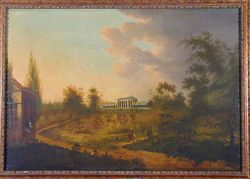
- Loudon, J. C. (John Claudius), 1850, describing botanic gardens in America (1850: 334)[25]
- “858. The American government has shown itself not insensible to the advantages of encouraging among its subjects a feeling for other pursuits than those connected with mere mercantile speculations. Seated in a country rich beyond all others in stores of botanical wealth, it would have been indeed surprising if the study of botany had not been among the first of those objects which the American government felt itself bound to patronise. Accordingly, we find botanic gardens and professorships attached to the American universities, and expeditions fitted out for the purpose of making scientific discoveries. . . (Gard. Mag., vol. i. p. 52.) . . .
- “859. . . There were in America, at an early period, men who recommended the necessity of instituting botanic gardens, as Lieutenant-Governor Colden and Dr. Middleton of New York, in 1769; and, upon the revival of the medical school in Columbia College, in 1792, a chair of botany was established, and Dr. Mitchel was appointed professor. Dr. Hosack succeeded Dr. Mitchel; and the result was, first, the latter professor’s establishing a botanical garden at his own expense, and afterwards government purchasing it of him for the benefit of the medical schools of New York; and it is now known as the New York Botanic Garden.
- “860. The Botanic Garden of New York contains twenty acres: the first catalogue was published in 1806, and the second in 1811, containing nearly 4000 species. (Statement, &c., as to the Elgin Botanical Garden, by Dr. Hosack. New York, 1811.) . . . [Fig. 17]
- “862. The Botanical Garden at Cambridge, in the state of Massachusetts, was commenced, in 1801, by subscription. The object of the establishment is the promotion of knowledge in native and foreign plants useful in agriculture, horticulture, and medicine, as well as the encouragement of the sciences of botany and entomology. There being no competent knowledge in the country as to what were the wants of a botanic garden, the professor, Peck, was sent to Europe, and returned with plans, and a collection of books. This garden suffered for some time from want of funds, and would long since have followed the fate of the Charleston public garden, founded by Dr. Hosack (which was purchased by the state at the price of 70,000 dollars), and would, like it, have been converted into a wilderness, had not the visitors applied for and obtained the aid of the legislature. . . (New York Farmer, vol. i., p. 185.) . . .
- “863. A botanic garden at Baltimore was commenced in 1830; and an extensive correspondence with the nurserymen and curators of botanic gardens in Europe will, it is hoped, soon procure for it a respectable collection. (Gard. Mag., vol. vii. p. 668.)"
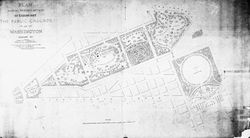
- Downing, Andrew Jackson, 1851, describing plans for improving the public grounds in Washington, DC (quoted in Washburn 1967: 55)[26]
- “6th: The Botanic Garden.
- “This is the spot already selected for this purpose and containing three green-houses. It will probably at some future time, be filled with a collection of hardy plants. I have only shown how the carriage-drive should pass through it (Crossing the canal again here) and making the exit by a large gateway opposite the middle gate of the Capitol Grounds.” [Fig. 18]
Citations
- Drowne, Solomon, c. 1810, Manuscript on Botany (Brown University, John Hay Library, Drowne Family Papers, typescript)
- “The advantageous application of botanical knowledge to Agriculture, to Gardening, Medicine, and other arts, is generally acknowledged. . . Surely the study of Natural History may well occupy Some portion of the time of the rising generation, and it is to be hoped the Trustees of the University will see the prosperity of giving some substantial encouragement for its extension among us. . . It is however, necessary to the progress of this Science, that the student should be supplied with actual and living specimens. The imperfection of language to give an adequate idea of any vegetable production must be generally admitted and the most beautiful & accurate drawings or engravings fall so far short of that delicacy & minuteness of parts,—those peculiarities incident to its part or habit & growth, on which its scientific distinctions depend; that it is only from living plants we can hope to obtain those distinctions which are necessary to discriminate these numerous productions, or to extend the limits of science itself. How important then must be the advantages of a Botanic garden properly laid out, and supplied with every beautiful production of vegetable nature which this country abundantly affords. To unbend the mind from studies, and renovate the habituated faults and corporeal powers, by withdrawing at times from the busy scenes of life,—those confining occupations, which, however lucrative, induce obstinate maladies,—is worth the endeavours of the wise. And what place so fit for exercise and innocent recreation as a garden furnished with a pleasing variety of plants. . . it must be admitted that the plan & disposal of a Botanic garden do not necessarily preclude elegance of design nor beauty of arrangement. To walk amid so many species of plants, assembled from different Countries, and inhale their rich perfumes; to mark their varied forms, apprized of the healing virtues of some, and of the beneficial purposes for which all were ordained,—must to the contemplative mind afford no common gratification.” [Fig. 19]

- Loudon, J. C. (John Claudius), 1826, An Encyclopaedia of Gardening (1826: 800, 1030)[27]
- “6126. The botanic flower-garden being intended to display something of the extent and variety of the vegetable kingdom, as well as its resemblances and differences, should obviously be arranged according to some system or method of study. In modern times, the choice is almost limited to the artificial system of Linneaus, and the natural method of Jussieu, though Adanson has given above fifty-six different methods by which plants may be arranged. . . Whatever method is adopted, the plants may either be placed in regular rows, or each order may be grouped apart, and surrounded by turf or gravel. For a private botanic garden, the mode of grouping on turf is much the most elegant. . .
- “7323. Botanic gardens. The primary object of botanic gardens is to exhibit a collection of plants for the improvement of botanical science; a secondary object to exhibit living specimens of such plants as are useful in medicine, agriculture, and other arts; and a third is, or ought to be, the acclimating of foreign plants, and their dissemination over the country. In choosing a situation for a botanic garden, the leading object must be proximity to the town, city, or university to which it is to belong; and the next, if attainable, a variety of surface and soil, to aid the necessary formation of composts and aspects for different plants. . . As the leading object or feature in the view of a botanic garden is the range of hot-houses; and as these must always face the south, it is generally desirable that ground on the north side of the principal public street or road by which it is to be approached, should be preferred to ground on the south side.
- “7325. The form of a botanic garden is a matter of very little consequence: where the extent is small, a square or parallelogram may undoubtedly be made to contain most plants; but where it exceeds four or five acres, any form will answer; and, indeed, if there is a sufficient quantity of ground, the more irregular the form, so much the more variety will there be in the circumferential walks of the garden.” [Fig. 20]
- Webster, Noah, 1828, An American Dictionary of the English Language (1828: 1:n.p.)[28]
- “BOTAN'IC, BOTAN'ICAL, a. [See Botany.] Pertaining to botany; relating to plants in general; also, containing plants, as a botanic garden.”
- Dearborn, H. A. S., September 19, 1829, An Address, Delivered Before the Massachusetts Horticultural Society (1833: 16)[29]
- “The natural divisions of Horticulture are the Kitchen Garden, Seminary, Nursery, Fruit Trees and Vines, Flowers and Green Houses, the Botanical and Medical Garden, and Landscape, or Picturesque Gardening.”
- Loudon, Jane, 1845, Gardening for Ladies (1845: 133)[30]
- “BOTANIC GARDEN.—A garden devoted to the culture of plants with a view to botanical science; and in which the plants are arranged according to some system, only one of a kind is planted, and a name appended to each. The most convenient mode for study is to place the plants in straight rows of narrow beds, one row in a bed, with a narrow path between; but the best mode for effect is to place them in groups of one order, tribe, or genus in a group. These groups have the best effect when of a circular form, and when placed on a lawn. The position of the groups relatively to each other should be such as to correspond with the botanical system followed.”
- Webster, Noah, 1848, An American Dictionary of the English Language (1848: 139)[31]
- “BO-TAN'IC, BO-TAN'IC-AL, a. [See BOTANY.] Pertaining to botany; relating to plants in general; also, containing plants; as, a botanic garden.
- “Botanic garden: a garden devoted to the culture of plants, collected for the purpose of illustrating the science of botany.”
Images
Inscribed
William Satchwell Leney after Louis Simond, View of the botanic garden at Elgin in the vicinity of the City of New York, ca. 1810.
William Satchwell Leney after Hugh Reinagle, "View of the Botanic Garden of the State of New York,” in David Hosack, Hortus Elginensis (1811), frontispiece.
John Diamond, Plat of a Tract of Land Called French Botanic Gardens Containing 120 Acres Located in Goose Creek Parish, September 1816.
Charles Bulfinch, Plan of Grounds adjacent to the Capitol, 1822. "Botanic Garden" is in the middle of the plan, in front of the Capitol.
J. C. Loudon, The botanic flower garden with a gravel-walk, in An Encyclopædia of Gardening (1826), p. 801, fig. 553.
Anonymous, Map of Mr. Andrew Parmentier’s Horticultural & Botanic Garden, at Brooklyn, Long Island, Two Miles From the City of New York, c. 1828.
Alexander Jackson Davis, Design for University of Michigan (elevation and plan of building and grounds), c. 1838.
Robert Mills, Plan of the Mall, Washington, DC, 1841. “[W]ith a view to a Botanic Garden", seen left of the center of the plan.
Anonymous, “Ground Plan of a portion of Downing’s Botanic Gardens and Nurseries,” in Magazine of Horticulture 7 (November 1841): 404.
A. J. Downing, Plan showing proposed method of laying out the public grounds at Washington, 1851. “Botanic Garden” inscribed at left.
A. J. Downing, Plan Showing Proposed Method of Laying Out the Public Grounds at Washington, 1851. Manuscript copy by Nathaniel Michler, 1867.
A. J. Downing, Plan Showing Proposed Method of Laying Out the Public Grounds at Washington, 1851 [detail]. Manuscript copy by Nathaniel Michler, 1867.
Associated
John or William Bartram, "A Draught of John Bartram’s House and Garden as it appears from the River", 1758
Samuel Vaughan, Plan of Mount Vernon, 1787.
John Trumbull, Dr. Hosack’s Green houses, Elgin Botanic Garden, June 1806.
Anonymous, Elgin Botanic Garden, c. 1810.
Hugh Reinagle, Elgin Garden on Fifth Avenue, c. 1812.
Benjamin Henry Latrobe, Plan of the Capitol grounds, 1815.
Thomas Jefferson, Third variant for range and gardens, showing serpentine walls at the University of Virginia, c. 1817–22.
Robert Mills, Alternative plan for the grounds of the National Institution, 1841.
Attributed
Anonymous, Map of the Columbian Institute’s plot for a botanical garden on the Mall, 1820.
Notes
- ↑ Manasseh Cutler, Life, Journals, and Correspondence of Rev. Manasseh Cutler, ed. William Parker Cutler and Julia Perkin Cutler, 2 vols. (Cincinnati: Robert Clarke & Co, 1888), 2:145, view on Zotero.
- ↑ Therese O’Malley, “‘A Public Museum of Trees’: Mid-Nineteenth Century Plans for the Mall,” in The Mall in Washington 1791–1991, ed. Richard Longstreth (Washington, DC: National Gallery of Art, 1991), 60–76, view on Zotero.
- ↑ 3.0 3.1 David Hosack, Hortus Elginensis, Or, A Catalogue of Plants, Indigenous and Exotic, Cultivated in the Elgin Botanic Garden, in the Vicinity of the City of New-York : Established in 1801, 2nd ed. (New York: T. & J. Swords, 1811), view on Zotero.
- ↑ George Washington, The Diaries of George Washington, ed. Donald Jackson and Dorothy Twohig, 6 vols. (Charlottesville: University Press of Virginia, 1978), view on Zotero.
- ↑ William Parker Cutler, Life, Journals, and Correspondence of Rev. Manasseh Cutler, LL.D. (Athens, OH: Ohio University Press, 1987), view on Zotero.
- ↑ Timothy Dwight, Travels; in New-England and New-York, 4 vols. (New Haven: T. Dwight, 1821), view on Zotero.
- ↑ François André Michaux, Travels to the West of the Alleghany Mountains, in the States of Ohio, Kentucky, and Tennessea, and back to Charleston, by the Upper Carolines. . . Undertaken, in the Year 1802, 2nd ed. (London: B. Crosby & Co. and J. F. Hughes, 1805), view on Zotero.
- ↑ David Hosack, A Catalogue of Plants Contained in the Botanic Garden at Elgin: In the Vicinity of New York, Established in 1801 (New York: T. & J. Swords, 1806), view on Zotero.
- ↑ 9.0 9.1 9.2 9.3 9.4 9.5 Therese O’Malley, “Art and Science in American Landscape Architecture: The National Mall, Washington, DC 1791–1852” (PhD diss., University of Pennsylvania, 1989), view on Zotero.
- ↑ 10.0 10.1 10.2 10.3 Thomas Jefferson, The Garden Book, ed. Edwin M. Betts (Philadelphia: American Philosophical Society, 1944), view on Zotero.
- ↑ Lillian B. Miller et al, eds., The Selected Papers of Charles Willson Peale and His Family, vol. 3, The Belfield Farm Years, 1810–1820 (New Haven, CT: Yale University Press, 1991), view on Zotero.
- ↑ Frederick Pursh, Flora Americae Septentrionalis; Or, a Systematic Arrangement and Description of the Plants of North America, 2 vols. (London: White, Cochrane & Co., 1814), view on Zotero.
- ↑ Benjamin Guild, “Botanic Garden,” New England Farmer 2, no. 8 (September 20, 1823): 62, view on Zotero.
- ↑ James Boyd, A History of the Pennsylvania Horticultural Society, 1827–1927 (Philadelphia: Pennsylvania Horticultural Society, 1929), view on Zotero.
- ↑ Benjamin Guild, “Medical Botany, Horticulture Experiments, &c.,” New England Farmer, and Horticultural Journal 8, no. 6 (August 28, 1829): 46, view on Zotero.
- ↑ J. W. S., “Foreign Notices: North America,” Gardener’s Magazine and Register of Rural & Domestic Improvement 8, no. 36 (February 1832): 70–77, view on Zotero.
- ↑ William Wynne, “Some Account of the Nursery Gardens and the State of Horticulture in the Neighbourhood of Philadelphia, with Remarks on the Subject of the Emigration of British Gardens to the United States,” Gardener’s Magazine and Register of Rural & Domestic Improvement 8, no. 38 (June 1832): 272–76, view on Zotero.
- ↑ Harriet Martineau, Retrospect of Western Travel, 2 vols. (London: Saunders and Otley, 1838), view on Zotero.
- ↑ Columella [pseud.], “Experimental Farm and Garden,” Horticultural Register, and Gardener’s Magazine 4 (March 1, 1838): 84–91, view on Zotero.
- ↑ Anonymous, “Miscellaneous Matters,” Horticultural Register, and Gardener’s Magazine 4 (June 1, 1838): 238–39, view on Zotero.
- ↑ Alexander Gordon, “Orange Groves of Florida,” Horticultural Register, and Gardener’s Magazine 4 (November 1, 1838): 417–19, view on Zotero.
- ↑ Joel R. Poinsett, Discourse, on the Objects and Importance of the National Institution for the Promotion of Science: Established at Washington, 1840, Delivered at the First Anniversary (Washington, DC: P. Force, Printer, 1841), view on Zotero.
- ↑ Pamela Scott, ed., The Papers of Robert Mills (Wilmington, DE: Scholarly Resources, 1990), view on Zotero.
- ↑ 24.0 24.1 24.2 William Darlington, Memorials of John Bartram and Humphry Marshall: With Notices of Their Botanical Contemporaries (Philadelphia: Lindsay & Blakiston, 1849), view on Zotero.
- ↑ J. C. (John Claudius) Loudon, An Encyclopaedia of Gardening; Comprising the Theory and Practice of Horticulture, Floriculture, Arboriculture, and Landscape-Gardening, new ed. (London: Longman et al., 1850), view on Zotero.
- ↑ Wilcomb E. Washburn, "Vision of Life for the Mall,” AIA Journal, 47 (1967), 52–59, view on Zotero.
- ↑ J. C. (John Claudius) Loudon, An Encyclopaedia of Gardening; Comprising the Theory and Practice of Horticulture, Floriculture, Arboriculture, and Landscape-Gardening, 4th ed. (London: Longman et al., 1826), view on Zotero.
- ↑ Noah Webster, An American Dictionary of the English Language, 2 vols. (New York: S. Converse, 1828), view on Zotero.
- ↑ H. A. S. (Henry Alexander Scammell) Dearborn, An Address Delivered before the Massachusetts Horticultural Society (Boston: J. T. Buckingham, 1833), view on Zotero.
- ↑ Jane Loudon, Gardening for Ladies; and Companion to the Flower-Garden, ed. A. J. Downing (New York: Wiley & Putnam, 1845), view on Zotero.
- ↑ Noah Webster, An American Dictionary of the English Language. . . Revised and Enlarged by Chauncey A. Goodrich. . . (Springfield, MA: George and Charles Merriam, 1848), view on Zotero.
